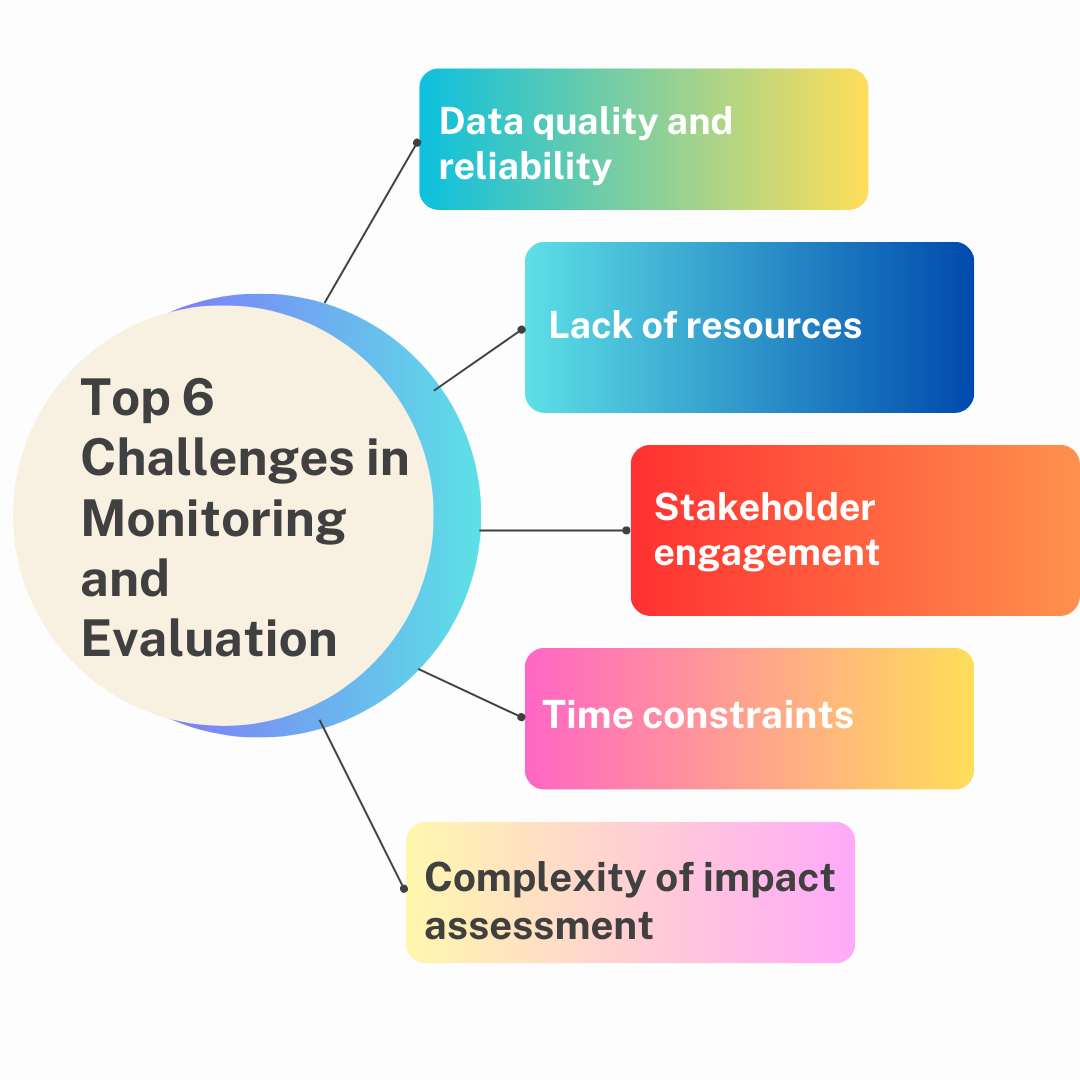Contents
- 1 What is Monitoring and Evaluation?
- 2 What is the Difference between Monitoring and Evaluation?
- 3 Monitoring and Evaluation Process: Steps and Challenges
- 4 Top 6 Challenges in Monitoring and Evaluation
- 5 How to Develop a Monitoring and Evaluation Plan
- 6 6 Key Benefits Of Monitoring & Evaluation
- 7 Certified Monitoring & Evaluation Certificate and Training
What is Monitoring and Evaluation?
Monitoring and evaluation (M&E) is a methodical process that involves acquiring, analyzing, and interpreting data in order to evaluate the development, efficacy, and impact of initiatives, programs, policies, or interventions.
It is an essential component of the cycle of planning, implementing, and improving because it gives decision-makers the evidence-based information that they require to make educated choices and promote accountability.
What is the Difference between Monitoring and Evaluation?
Monitoring:
Definition: Monitoring refers to the systematic and ongoing collection of data and information to track the progress and performance of a project, program, or policy.
Purpose: The primary purpose of monitoring is to provide real-time information on the implementation process. It helps identify whether activities are being carried out as planned, whether resources are being utilized effectively, and whether targets and objectives are being achieved.
Timeframe: Monitoring is conducted throughout the entire duration of a project or program, starting from the initial stages to the completion.
Focus: Monitoring focuses on tracking inputs, activities, outputs, and outcomes in order to identify any deviations from the planned course. It ensures that the project is on track and allows for timely adjustments and corrective measures if necessary.
Methods: Monitoring involves regular data collection, observations, progress reports, site visits, and other mechanisms to gather relevant information. It can be conducted internally by project staff or externally by independent monitors.
[media-credit id=”1″ align=”none” width=”731″] [/media-credit]
[/media-credit]
Evaluation:
Definition: Evaluation is a systematic assessment of a project, program, or policy to determine its relevance, efficiency, effectiveness, impact, and sustainability.
Purpose: The primary purpose of evaluation is to assess the overall performance and outcomes of a project or program. It aims to provide an independent and comprehensive analysis of the intervention’s achievements, strengths, weaknesses, and lessons learned.
Timeframe: Evaluation typically takes place at specific points during or after the completion of a project or program, such as mid-term or final evaluations.
Focus: Evaluation examines the causal relationship between the intervention and its outcomes, and it assesses the extent to which the intervention has achieved its intended objectives. It helps stakeholders understand what worked, what did not work, and why, and provides recommendations for future improvements.
Methods: Evaluation involves various data collection methods, such as surveys, interviews, focus groups, case studies, and statistical analysis. It often includes comparing the achieved results against predetermined targets and benchmarks.
ALSO READ : Monitoring and Evaluation Methodologies
Monitoring and Evaluation Process: Steps and Challenges
The monitoring and evaluation (M&E) process is an essential component of project management and is used to assess the progress, effectiveness, and impact of programs, policies, or interventions. It involves systematically collecting and analyzing data.
Here are the steps involved in the M&E process, along with some common challenges:
[media-credit name=”Getty Images/iStockphoto” align=”none” width=”515″]

Define goals and objectives: Clearly articulate the goals and objectives of the project or program, ensuring they are specific, measurable, achievable, relevant, and time-bound (SMART). This step sets the foundation for the monitoring and evaluation process
Develop indicators: Identify and establish specific indicators that will be used to measure progress and success in achieving the defined goals and objectives. Indicators should be meaningful, quantifiable, and aligned with the goals of the project.
Data collection: Determine the appropriate data collection methods and tools to gather relevant information. This may include surveys, interviews, focus groups, observations, or existing data sources. Data should be collected consistently and at regular intervals to track progress over time.
Data analysis: Analyze the collected data to extract meaningful insights and evaluate the performance of the project or program. This step involves organizing, interpreting, and summarizing the data using appropriate statistical or qualitative analysis techniques.
Reporting and communication: Prepare clear and concise reports presenting the findings and recommendations derived from the data analysis. These reports should be tailored to different stakeholders, such as project managers, funders, and policymakers, and should effectively communicate the progress, achievements, challenges, and areas for improvement.
Learning and adaptation: Utilize the evaluation findings to inform decision-making and improve the project or program. Identify lessons learned and best practices that can be applied to future initiatives. Continuously adapt and refine strategies based on the M&E results.
Top 6 Challenges in Monitoring and Evaluation
[media-credit id=”1″ align=”none” width=”417″]

a.) Data quality and reliability: Ensuring the accuracy, completeness, and consistency of the data collected can be challenging. Issues may arise from data entry errors, biases in data collection methods, or inadequate sample sizes.
b.) Lack of resources: Limited financial, human, and technological resources can hinder the M&E process. Insufficient funding, shortage of skilled personnel, and lack of appropriate tools or technology may impede effective monitoring and evaluation.
c.) Stakeholder engagement: Engaging relevant stakeholders throughout the M&E process is crucial for obtaining comprehensive and meaningful insights. However, it can be challenging to involve all relevant parties and maintain their active participation, which may affect the quality and relevance of the evaluation.
d.) Time constraints: Conducting a comprehensive M&E process requires sufficient time for data collection, analysis, and reporting. However, project timelines and deadlines may limit the available time, potentially compromising the depth and rigor of the evaluation.
e.) Complexity of impact assessment: Measuring the impact or attributing changes solely to the project or program can be complex. Distinguishing the project’s influence from other external factors requires robust evaluation designs, control groups, or statistical techniques.
f.) Limited utilization of evaluation findings: Despite investing time and effort into monitoring and evaluation, the actual utilization of the findings for decision-making and program improvement may be limited. Creating a culture that values evidence-based decision-making is crucial to address this challenge.
How to Develop a Monitoring and Evaluation Plan


Developing a monitoring and evaluation (M&E) plan is crucial for assessing the progress, effectiveness, and impact of a project, program, or intervention. It helps organizations gather data, track performance indicators, and make informed decisions based on evidence. Here are the steps to develop an M&E plan:
- Define the purpose and scope: Clearly articulate the objectives and goals of your project or program. Determine the scope of your M&E plan by identifying what aspects you will monitor and evaluate.
- Identify key stakeholders: Identify the individuals or organizations who have an interest or involvement in your project.
- Define measurable indicators: Develop specific and measurable indicators that will help you assess progress towards your objectives. Indicators should be realistic, relevant, time-bound, and aligned with your project goals.
- Determine data collection methods: Decide how you will collect data for your indicators. This can include quantitative methods (surveys, interviews, observations) and qualitative methods (focus groups, case studies, interviews).
- Establish data sources: Identify the sources of data for each indicator. This could include existing data (e.g., government statistics), primary data collection (e.g.surveys), or data from partners and stakeholders. Determine the frequency and timing of data collection.
- Allocate resources: Identify the resources needed for implementing the M&E plan. This includes human resources, financial resources, technology, and training. Ensure that you have the necessary capacity and support for data collection, analysis, and reporting.
- Develop a data management system: Establish a system for data management, including data storage, organization, and security. Decide how you will handle data entry, data cleaning, and data quality assurance.
- Plan reporting and communication: Determine how you will report and communicate the findings from your M&E activities. Identify the key stakeholders who will receive the reports, and tailor the information to their needs.
6 Key Benefits Of Monitoring & Evaluation
Monitoring and evaluation (M&E) is a critical process in various fields, including project management, development programs, and policy implementation. It involves systematically collecting and analyzing data to assess the progress, performance, and impact of activities. Here are six key benefits of monitoring and evaluation:
- Improved Decision-Making: M&E provides valuable information and evidence that enables informed decision-making. By regularly monitoring and evaluating projects or programs, stakeholders can identify strengths, weaknesses, and areas that require improvement. This information helps guide future actions and allocate resources more effectively.
- Enhanced Accountability: M&E promotes accountability by establishing clear performance indicators and measuring progress against them. It holds individuals, organizations, and governments responsible for achieving their objectives and delivering results. Transparent monitoring and evaluation systems foster a culture of responsibility, ensuring that resources are utilized efficiently and effectively.
- Increased Efficiency and Effectiveness: Through M&E, organizations can identify bottlenecks, inefficiencies, and areas of underperformance. This knowledge allows for adjustments and corrective actions to be taken promptly, optimizing project implementation. By focusing on evidence-based practices, M&E enhances the effectiveness and efficiency of interventions, leading to better outcomes.
- Learning and Knowledge Sharing: M&E facilitates continuous learning and knowledge sharing within organizations and across sectors. It encourages reflection on what works and what doesn’t, enabling stakeholders to adapt strategies and approaches accordingly. Valuable lessons and best practices can be identified, documented, and shared, improving future programming and avoiding the repetition of past mistakes.
- Evidence-Based Advocacy: Monitoring and evaluation generates robust evidence that can be used for advocacy purposes. Data and findings from M&E activities can support the case for policy changes, resource allocation, or further investment in specific areas. Strong evidence-based advocacy can influence decision-makers, shape policies, and mobilize support for initiatives, ultimately leading to positive change.
- Stakeholder Engagement and Participation: M&E encourages active stakeholder engagement and participation throughout the project or program cycle. By involving stakeholders in the design and implementation of monitoring systems, their perspectives and feedback are integrated into the evaluation process. This participatory approach fosters ownership, transparency,
Certified Monitoring & Evaluation Certificate and Training
At Indepth Research Institute (IRES) we offer training and certification programs in Monitoring and Evaluation (M&E).
Certified Monitoring and Evaluation programs aim to enhance the skills and knowledge of professionals working in the field of M&E. These programs typically cover various aspects of monitoring and evaluation methodologies, tools, techniques, and best practices.
They are designed to equip participants with the necessary skills to plan, implement, and manage effective monitoring and evaluation systems for projects, programs, and organizations.
The specific content and duration of the program may vary depending on the institute and the level of certification. Some programs may offer a foundational certificate, while others may provide advanced certificates or diplomas. It’s essential to review the curriculum and prerequisites to ensure that the program aligns with your needs and level of expertise.
Remember to conduct thorough research and consider factors such as the institute’s reputation, faculty expertise, and alumni feedback before making a decision to pursue a specific certification or training program in Monitoring and Evaluation.
[wpforms id=”1833″]
We have a firm belief that every organization has a unique purpose only they can fulfil in this world. We work with you in organizing your resources to exploit opportunities so that you can fulfil your purpose and realize full potential. We build the capacity of people, processes and systems for organizational success and growth as well as nurturing a thriving ecosystem.
Ready to enhance your skills and boost your career? Explore our corporate training programs now and start your journey to success.








Comment here